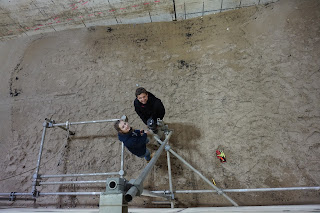That's a wrap everyone! We have now finished our time in the GWK flume. On our final day yesterday, we tested the response of our revetment with added thickness at the face to both normal and storm wave conditions. The revetment began with an initial slope of 1:4. Firstly, when exposed to 2 hours of normal waves (Hs = 0.8m, Tp = 6s), the revetment did not change much at all. We then applied storm waves (Hs = 1m, Tp = 8s), in which we observed the same behaviour as in previous tests - the revetment flattened in response to the larger waves (approaching 1:6 slope), mostly as a result of large overtopping events bringing down the crest. We then reverted back to normal wave conditions for 2 hours to rebuild the revetment crest and front face slope to roughly 1:4.
Following these tests we ran even bigger storm waves (Hs = 1m, Tp = 9s). Surprisingly, the revetment did not flatten out in response to these larger waves - in fact, the crest of the revetment began to build upwards! In addition the revetment was translating landwards! Another test with EVEN BIGGER waves (Hs = 1.2m, Tp = 8s) still could not destroy the revetment, it did not flatten out and also managed to accrete a little bit. How dynamic is this thing?! We will have to analyse the profiles further, although one clear observation was that for these latter tests, overtopped water receded back through the core of the now thicker revetment - protecting the crest from backwash.
Today, Paul and I have been cleaning up the flume and the gear. A huge thanks to everyone that was involved in the experiment. We now get to jump into the data, make some discoveries and hopefully change the world!
 |
| Figure 2 - Deconstructing the revetment :( |






























